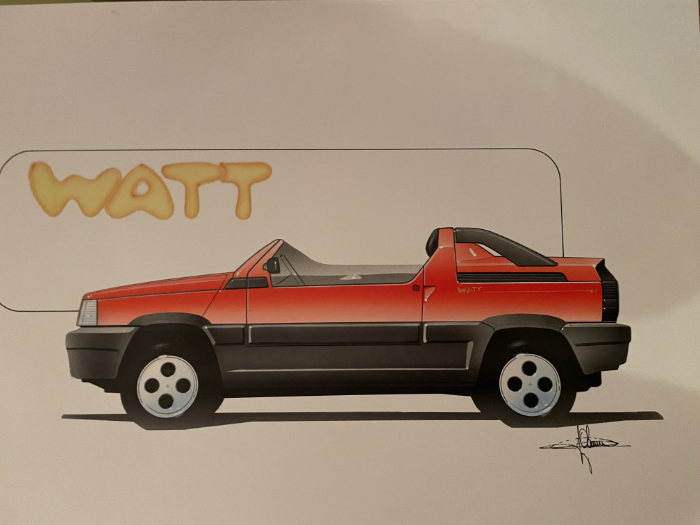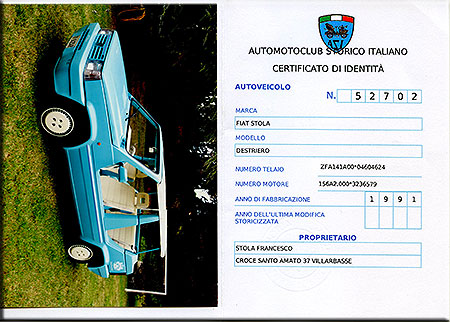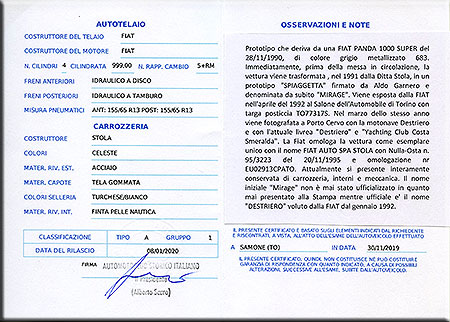MARZO 1991
 1964 Fiat 500 Jolly bodied Ghia.In mid-March of 1991, with the enthusiasm of Proteo's presentation in Geneva, Roberto Stola confidently granted his nephew Alfredo the management of a new show car based on the Fiat Panda, to create a "beach" version inspired by the Fiat 500 and 600 Jolly Ghia of the 60s.
1964 Fiat 500 Jolly bodied Ghia.In mid-March of 1991, with the enthusiasm of Proteo's presentation in Geneva, Roberto Stola confidently granted his nephew Alfredo the management of a new show car based on the Fiat Panda, to create a "beach" version inspired by the Fiat 500 and 600 Jolly Ghia of the 60s.
The aim was to show the company's manufacturing capabilities without the restrictions of industrial confidentiality of its customers.
Alfredo and Maria Paola followed this project with passion, listening to the advice of Giuseppe Civardi, technical manager of the Fiat Style Center in Via La Manta, Turin.
 Saluzzo 1991 Aldo Garnero in a photo of the time in his Euro Design Engineering studio.
Saluzzo 1991 Aldo Garnero in a photo of the time in his Euro Design Engineering studio.
 April 1991. The chosen design by Aldo Garnero.
April 1991. The chosen design by Aldo Garnero.
The project name is Maui, the palm tree graphics are inspired by the Mirage hotel in Las Vegas
 April 1991 A second proposal by Aldo Garnero rejected by the Stola family.
April 1991 A second proposal by Aldo Garnero rejected by the Stola family. April 1991 A third proposal by Aldo Garnero rejected by the Stola family.
April 1991 A third proposal by Aldo Garnero rejected by the Stola family.
 Rivalta in May 1991 at the Opac. Alfredo Stola poses with the body of the Panda under construction.
Rivalta in May 1991 at the Opac. Alfredo Stola poses with the body of the Panda under construction.
Robaldo can be seen in the background.


 Rivalta May 1991 At the Opac we recognize Rodolfo Robaldo of the Stola s.p.a. and Sergio Fraire of Opac.
Rivalta May 1991 At the Opac we recognize Rodolfo Robaldo of the Stola s.p.a. and Sergio Fraire of Opac. Rivalta May 1991 At the Opac we recognize Rodolfo Robaldo of the Stola s.p.a. and Sergio Fraire of Opac.
Rivalta May 1991 At the Opac we recognize Rodolfo Robaldo of the Stola s.p.a. and Sergio Fraire of Opac.

 Turin 12 July 1991 At the Pubblimais in Strada della Pronda 135/9 the Mirage logo is hand painted by the owner Vinicio Mais.
Turin 12 July 1991 At the Pubblimais in Strada della Pronda 135/9 the Mirage logo is hand painted by the owner Vinicio Mais. Turin 12th July 1991. In the souvenir photo we recognize the son Roberto Mais and his cousin Lorenzo.
Turin 12th July 1991. In the souvenir photo we recognize the son Roberto Mais and his cousin Lorenzo.
 September 3, 1991 Portofino Maria Paola and Alfredo Stola for the first time on the Panda Mirage.
September 3, 1991 Portofino Maria Paola and Alfredo Stola for the first time on the Panda Mirage.
Note that the name Mirage appears under the three palm trees.
 3 September 1991 in Portofino the Panda Mirage is photographed for the first time with its original number plate TO64254R.
3 September 1991 in Portofino the Panda Mirage is photographed for the first time with its original number plate TO64254R. With the name Mirage it will never be published in any newspaper at the request of Fiat top management.
With the name Mirage it will never be published in any newspaper at the request of Fiat top management.
 September 1991. At the lake of Avigliana the first and only unofficial Sunday outing of the Panda Destriero together with his friend Fabrizio Giugiaro and his Special panda called "Strip".The designer was Aldo Garnero, the body was build by Opac and the upholstery by Salt of Gavina family.
September 1991. At the lake of Avigliana the first and only unofficial Sunday outing of the Panda Destriero together with his friend Fabrizio Giugiaro and his Special panda called "Strip".The designer was Aldo Garnero, the body was build by Opac and the upholstery by Salt of Gavina family.
The name of this "spiaggetta", photographed for the first time in the splendid setting of Portofino on 3 September 1991, was Mirage, which shortly afterwards would change to "Destriero" on the advice of Fiat's top managers, in particular that of the engineer Paolo Cantarella.
This perfectly functioning prototype would be the first of many concepts that STOLA spa will carry out on its own initiative for demonstration purposes towards its customers. The first prototype was registered in 1991 by STOLA s.p.a., bearing license plate TO 64254R and chassis number ZFA 141A0004604624.
The first prototype was registered in 1991 by STOLA s.p.a., bearing license plate TO 64254R and chassis number ZFA 141A0004604624.
On November 20th 1995, Fiat Auto s.p.a. authorised STOLA s.p.a. to proceed in updating the circulation documents of the vehicle into a doorless beach-car with the "nulla osta" GC / AA number N 95/3223.
The approval was issued by the Ministry of Transport and Navigation on 25 January 1996 and the transcription in the vehicle registration document takes place on February 1st of the previous year.
 March 1992 Porto Cervo, the Stola Panda Destriero in the first official photograph with the name Destriero, no longer Mirage. In the background you can see the great Destriero motorboat in preparation by the great business.
March 1992 Porto Cervo, the Stola Panda Destriero in the first official photograph with the name Destriero, no longer Mirage. In the background you can see the great Destriero motorboat in preparation by the great business.
The front registration plate (TO 77317S) for this picture was borrowed from another Fiat-owned vehicle for internal reasons. The first example of the Stola Panda Destriero has always been targed TO64254R, and it is so still today.
 October 1991 The project from Mirage will become Destriero at the request of Fiat Auto.The STOLA Panda Destriero had its the world premier at the Turin Motor Show in April 1992 on the Fiat stand.
October 1991 The project from Mirage will become Destriero at the request of Fiat Auto.The STOLA Panda Destriero had its the world premier at the Turin Motor Show in April 1992 on the Fiat stand.
The setting tells the story of the motor vessel Destriero, at whose rudder Cesare Fiorio and his crew would to try to win the blu ribband in for crossing the Atlantic for the Yachting Club Costa Smeralda.
Basically the STOLA Panda Destriero was the tender in Porto Cervo for the boats crew.
 Turin, April 23, 1992 Turin Motor Show Fiat stand.
Turin, April 23, 1992 Turin Motor Show Fiat stand.
 Turin, April 23, 1992 Turin Motor Show Fiat stand. Maria Paola and Alfredo Stola with the two month old Francesco in the special dedicated display of the Destriero motor vessel company.
Turin, April 23, 1992 Turin Motor Show Fiat stand. Maria Paola and Alfredo Stola with the two month old Francesco in the special dedicated display of the Destriero motor vessel company.
The front registration plate (TO 77317S) for this picture was borrowed from another Fiat-owned vehicle for internal reasons. The first example of the Stola Panda Destriero has always been targed TO64254R, and it is so still today.
 Nicola and Cristian D'Alessio of DN Trasporti. Always the transporters of Stola s.p.a.In end of June, a few months later the show, the Fiat Style Center requested a second twin STOLA Panda Destriero for the Avvocato Gianni Agnelli.
Nicola and Cristian D'Alessio of DN Trasporti. Always the transporters of Stola s.p.a.In end of June, a few months later the show, the Fiat Style Center requested a second twin STOLA Panda Destriero for the Avvocato Gianni Agnelli.
After having seen it, the Avvocato requires a change of color in the most classic blue used by the Agnelli family and a particular interior in light gray and the hood covering only the front seats.
 Villarbasse September 1992. For the first time here are the two Stola Panda Destriero twins. The one in the foreground without a canopy is intended for the Avvocato Gianni Agnelli.
Villarbasse September 1992. For the first time here are the two Stola Panda Destriero twins. The one in the foreground without a canopy is intended for the Avvocato Gianni Agnelli.
 October 1992 Alfredo Stola and little Francesco in the entrance hall of Via La Thuile before the delivery of the Destriero to the Fiat Style Center after the changes requested by the Avvocato Agnelli.
October 1992 Alfredo Stola and little Francesco in the entrance hall of Via La Thuile before the delivery of the Destriero to the Fiat Style Center after the changes requested by the Avvocato Agnelli. October 1992 The Stola Panda Destriero of the Avvocato just delivered and photographed in front of the offices of the Fiat Style Center in Via La Manta in Turin. You can see the particular hood covering only the front seats.
October 1992 The Stola Panda Destriero of the Avvocato just delivered and photographed in front of the offices of the Fiat Style Center in Via La Manta in Turin. You can see the particular hood covering only the front seats.
For Alfredo and Maria Paola the Mirage-Destriero was the car to for which they have so much affection, so much so that still today they use it during their holidays by the sea.
Their love for the Mirage-Destriero stems from the fact that the whole project was developed while their child Francesco was in his mothers womb, and at only two months old he would attend the world premier on the Fiat stand with his parents.
It is the period of the Panda Elettra produced by Fiat in 1990, during the development of the Mirage/Destriero, Alfredo Stola asked the designer Aldo Garnero to create some very sporty two-seater electric Panda proposals.


Following this great experience, STOLA spa created the slogan "No Style Design" in order to communicate and reassure its customers that the company would never deal with creating "style" with the exception of its demonstration prototypes, which in themselves would be created by designers who were friends from outside the company.
 Logo designed by STOLA spa to communicate to the manufactureres style centers that design is not its business.
Logo designed by STOLA spa to communicate to the manufactureres style centers that design is not its business.
To crown the passion for the Destriero,Francesco Stola's Canevese Ruote Classice club in Canavese was now owner of the rare beach car, on January 8th, 2020. ASI issued it with their "Targa Oro" certificate.
A thorough inspection took place in Samone in the province of Turin on 30 November 2019 by Commissioners Luigi Viceconte, Lorenzo Beltrami, and Rolando Pluma coordinated by Mario Alasia.
With the number 52702 the identity certificate of the "Fiat Stola Destriero" was classified as Type A, Group 1.


 Samone (To) November 30, 2019: the moments of verification with the commissioners Alasia, Viceconte, Beltrami and Pluma.
Samone (To) November 30, 2019: the moments of verification with the commissioners Alasia, Viceconte, Beltrami and Pluma. The gold plate will be given on January 8, 2020 by ASI through the Classic Wheels club in Canavese.
The gold plate will be given on January 8, 2020 by ASI through the Classic Wheels club in Canavese.


 Samone (To) 30 novembre 2019: una foto ricordo con i commissari dopo la stesura del verbale. Da sinistra A.Stola, Lorenzo Beltrami, Mario Alasia, Luigi Viceconte e Lorenzo Pluma.
Samone (To) 30 novembre 2019: una foto ricordo con i commissari dopo la stesura del verbale. Da sinistra A.Stola, Lorenzo Beltrami, Mario Alasia, Luigi Viceconte e Lorenzo Pluma.



























